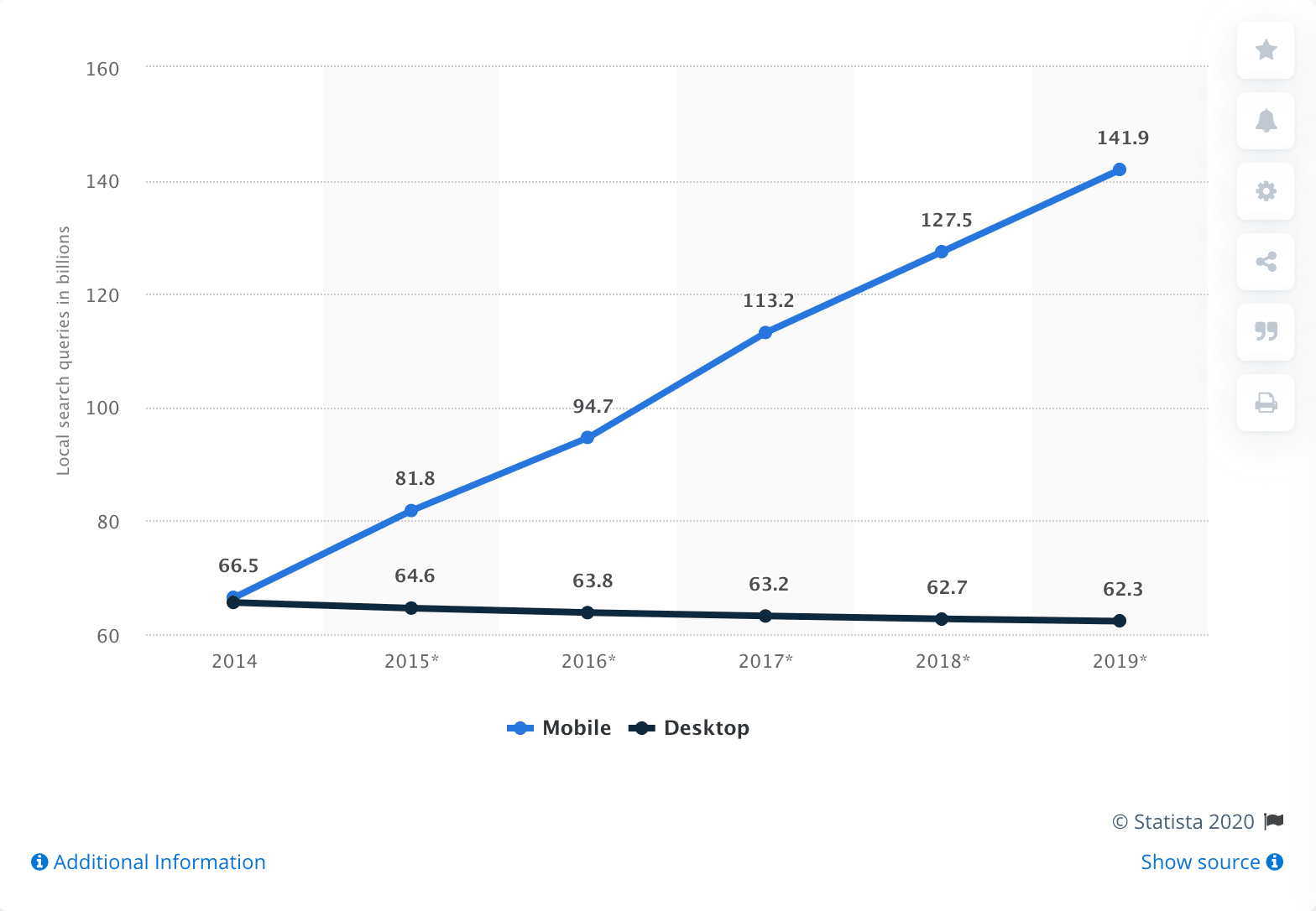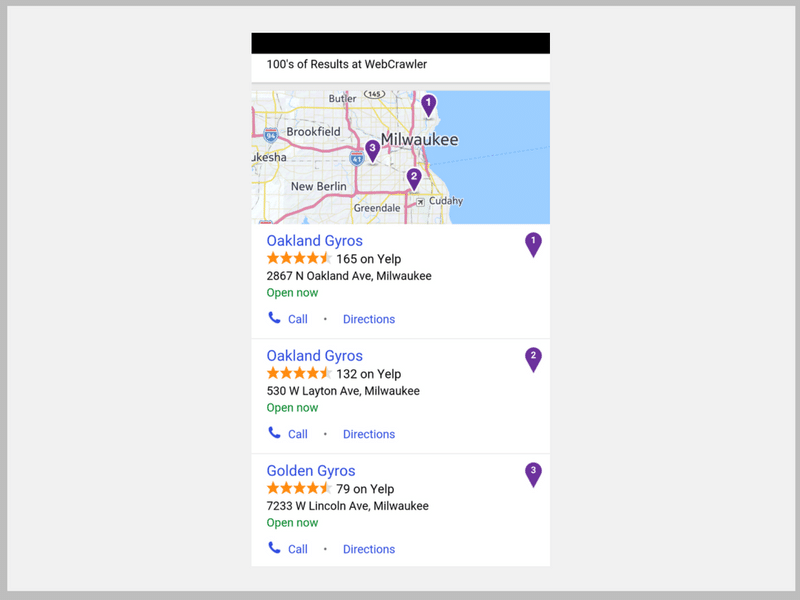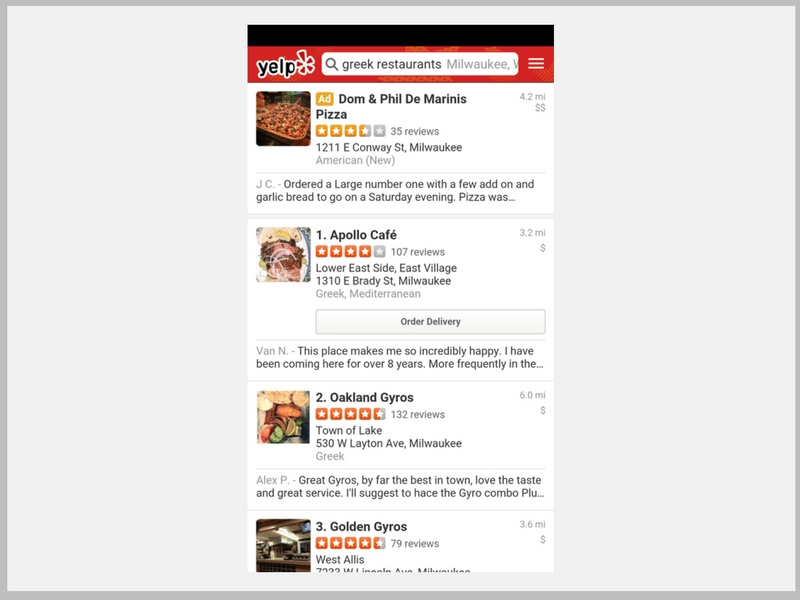Her brakes have just gone out.
Alina Tugend couldn’t drive her care home safely. To make matters worse, her two children were in the back seat. Fortunately for her, she was at a standstill. She was able to inch over to the shoulder using her emergency brakes.
Now she had another problem.
Who should she call for help? What should she say? She didn’t know much except that her brakes were out.
When she shared her story, she admitted it was scary. She had no idea what she should do or where to look first. In the end, things worked out.
Table of Contents
Get the Reputation You Deserve with Grade.us
The story of the impulse buyer
It’s common for impulse buyers to be seen as people with lots of discretionary income, pulling the “buy it now” trigger on anything that appeals to them.
The truth is, in reality, more nuanced. Impulse buys depend on context.
Google captured this in their micro-moments campaign. They show how these micro-moments create questions, desire, and curiosity.
- A pair of orange pumps create love at first sight, prompting the desire to search for a pair of her own.
- A father struggling to load his car, thinks "wouldn't it be nice if we had an SUV?" prompting him to search for what he wants; the Acura RDX.
Practically speaking, what does this mean?
According to John D. Wells, a researcher at the University of Massachusetts Amherst, there are four different types of impulse buyers.
- Planned impulse. Here’s a good example of an impulse buy that’s planned. You’re shopping at a store, and you’re ready to checkout. You see a banner ad that says “orders over $50 ship free.” You have $43 of product in your shopping cart. So you find some other product you need to qualify for free shipping.
- Pure impulse refers to an unplanned purchase you’ve made while browsing through products or services online (e.g., Amazon’s deal of the day or Cyber Monday sales).
- Reminder impulse. You’ve just purchased a camera, but you forgot to get a replacement battery pack. You quickly add it to your shopping cart then proceed to checkout.
- Suggestive impulse. This is exactly what it sounds like; you see a product or service recommendation. You realize you need what they’re selling. You purchase that product.
These impulse buys are all dependent on reviews as a conversion mechanism. A strong review portfolio for your product or service means customers are far more likely to act on these impulses when they appear.
What does this mean?
How do you identify the impulse buyers?
Micro-moments are an important piece of the inbound marketing funnel. They attract and convert customers in the moment, so the process is hyper-accelerated. Having your business SEO properly configured on major search engines and vertical search engines like Yelp helps your customers get the information they need in the middle of these impulse or need-it-now micro-moments.
Think back to Alina’s story; she needed:
- Someone to fix her car
- She'd need a ride home
- Food for herself and her kids
She was driven to search for a solution to her problem. But she also needed a way to evaluate each of the providers she encountered. In the absence of a personal or familial recommendation, what’s she going to rely on?
That’s right, reviews.
Her tool of choice? The Smartphone.
Research from Statista shows that mobile usage has exploded.

Has local search tracked with these changes?
- More than half of all web traffic comes from smartphones and tablets
- 46% of Google search queries have local intent
- 30% of all mobile searches are related to location
- A 2.1x increase in mobile searches for conversion-oriented queries, e.g., “stores open now” or “food open now” in the past year
- A 1.3x increase in mobile searches for conversion-oriented queries, e.g., “where to buy/find/get” in the past year
- A 50% increase in mobile searches related to “best products” over the last year
- 76% of people who search on their smartphones for something nearby visit a local business within one day
- 28% of those searches for something nearby result in a short term purchase
- 72% of shoppers who complete a local search will visit a store within 5 miles
- 56% of consumers shop equally online and offline
- Hyperlocal search queries, keywords ending with “Near me, Nearby or Close by” have increased by a whopping 900% in the last two years
What’s the connective tissue here?
All of these decisions are, at some point, going to require confirmation. Regardless of the industry, product, or service – customers want social proof. They want to verify that other customers have received the results you’ve promised.
This means reviews.
We’ve outlined the value and potential return of online reviews significantly in the past. Here are some ways that could play out for various local businesses.
- Customers check offline retail stores, large and small, for their hours of operation. Any search for your establishment will bring up your review portfolio across the big three (Google, Facebook, Yelp).
- Local attractions and holiday-specific outlets will prompt customers the search for information and reviews. Attractions and events with a stronger review portfolio will attract more customer attention.
- Accommodations – hotels, motels, bed and breakfasts, Airbnb, etc. – will attract a significant amount of searcher attention during the holidays. Customers will (use travel search engines like TripAdvisor) to identify top-performing accommodations. Locations with a strong and pristine review portfolio will receive the lion's share of the business.
- Service providers may be needed to help customers during the holidays or busy periods of the year. For example, plumbers or electricians with strong review portfolios may be called on to solve emergency issues for customers.
See what I mean?
Google reviews are front and center in each of these examples. Local search provides customers with your hours of operation, star, and review ratings on the SERPs and click to call.
Our mobile devices put the solutions to our problems at our fingertips. In a split second, we’re able to find a tow truck, restaurant, auto body shop – anything we need. But an impulse buy can’t give us the one thing we need most.
We need reassurance that things will be okay; we need to know we’re making the right choice when we buy because the wrong choice could be a disaster.
So we rely on customers to make that happen.
The very same customers who chose to share their experiences with the providers we are now considering. In one click, we can do the same thing, sharing our experience with Google searchers.
Or Bing.

Or Yahoo.

Or Yelp.

Or any other review site that has your customer’s undivided attention. And what are these customers looking for? Satisfaction.
And the only way for you to provide that satisfaction is to stay in front of customers. But there are hundreds of review sites. Where do you focus your attention?
1. Focus on customers demographics and psychographics
Your impulse buyers. The key to staying in front of your customers is knowing them deeply. Knowing your customers deeply means you know their desires, goals, fears, and frustrations. It means you know where they spend their time, how they spend their time, and more.
You see them as real people, rather than an imaginary persona.
This is the part where almost every business says, “We already know our customers.” Interview customers, conduct surveys, and new details appear. A good customer persona depends on actual interactions and information from your customers.
2. Map out customer micro-moments
Knowing your customers is a prerequisite – everything you do with your marketing afterward is dependent on who they are. Get it wrong, and your sales suffer as your marketing falls flat.
So how do you get it, right?
You map out their micro-moments. You approach your product (or service) from a customer’s point of view. Take our Greek restaurant, for example. What kind of micro-moments would prompt customers to look for you?
- Real estate virtual tours Brooklyn
- Local traditions
- Travelers on the highway looking for a place to eat
- Food truck nights
- Charity events and local causes
Most businesses have hundreds of micro-moments they can focus their attention on. Which moments matter most? Which ones are profitable? At first glance, this seems like an overwhelming problem; until you find the solution.
3. Let customers decide which moments matter most
Think about our Greek example: Are the vast majority of customers visiting these restaurants because they’re traveling? Are they hungry locals looking for a quick bite to eat at lunchtime? Greek natives with a craving for home?
Your marketing should position your business around these micro-moments, providing customers with the reviews, the social proof they’re desperately looking for.
What if you don’t have a strong review portfolio?
Here are some steps you can take to boost your review count and improve your review portfolio’s strength.
- Select a review management platform. A review management platform will automate the process, making it easier for you to receive reviews from happy and satisfied customers.
- Create review templates. You’ll want to create a series of templates you can use to request customer reviews. We’ve created a massive collection of templates you can customize for your needs.
- Ask customers for reviews. Research shows 70% of customers are willing to leave a review if asked. Most brands aren’t requesting reviews as often as they should.
- Respond to negative reviews. Responding to negative reviews is essential for several reasons (a.) a thoughtful response from brand owners/managers blunts the effect of a negative review. (b.) it gives you a chance, in small cases, to win customers back.
It’s not rocket science, right?
But it’s still incredibly important that you pursue reviews consistently. If your business is positioned around micro-moments, customer reviews should be positioned around your business. Wherever you present your business, prospective customers should see your reviews as well.
Doing this is essential because it:
- Reduces your advertising and marketing costs
- Increases your return on ad spend (ROAS)
- Increases your conversion rate
- Amplifies the effectiveness of your advertising and marketing campaigns
How can you use this information, and your reviews, to beat your competitors this holiday season?
3 ways your local businesses can beat online competitors this holiday season
You can use several strategies to attract more customers and bring in more online reviews this holiday season. It’s not complicated or difficult; it just requires some upfront preparation.
Let’s dive in.
Step #1: Supporting your community
A Clutch.co survey found consumers are more willing to spend more time and money with socially responsible companies. According to their research:
- 75% of consumers are more likely to begin shopping at a company that supports a social issue they agree with.
- 71% of people believe it's important for businesses to take a stance on social movements. Consumers want to see that the companies they choose align with their values.
- 70% of Gen Xers and 54% of Millennials are more likely to stop shopping at a business that supports an issue they disagree with compared to 37% of Baby Boomers.
What does this mean?
The landscape has changed. It’s no longer about providing an exceptional product or service and amazing customer service and support. If you’d like to win customers over, you’ll need to support your local community, showing that you’re willing to support the social causes that matter to your audience.
How do you do it, though?
- Charitable giving to causes that resonate with your audience. Upstreet Craft Brewing donated $10,000 to local charities to celebrate their fifth anniversary. If you’re not sure how to donate, take a look at this post from Double the Donation outlining how other companies give.

Source: NewsBreak.com
2. Improve labor policies and work conditions for your employees. Netflix offers employees 52 weeks of paid parental leave, which can be taken at any time.

Source: Netflix
- Volunteering in your local community. Emily Tewers, an employee at Michigan digital marketing firm OneUpWeb, volunteers with Glad Meals and Safe Harbor. She’s part of a team that volunteers to take care of the homeless in their city.

Source: OneUpWeb
- Creating corporate policies that benefit the local community. This could be sourcing ingredients and materials locally, using organic materials in your production or manufacturing process, cruelty-free manufacturing, or purchasing locally made goods.
- Making socially conscious investments in your community. Dan Price, CEO of Seattle-based payment processing company Gravity Payments, decided to raise all of his 120 employees’ salary to a minimum of $70,000 per year. This created a firestorm of discussion, spreading to other businesses, and spawning a movement.

Source: Inc.
- Becoming environmentally conscious. Thirty-one businesses in Madison, Wisconsin, launched an initiative to save energy and save money and reduce their community’s carbon emissions. Working together, they were able to reduce carbon dioxide levels by 1.5 million pounds.
Here’s the thing about serving your community.
It has a cascading effect that generates more positive growth for your business. You support the community, attracting more customers in the process. You help to keep local suppliers in business, improving the stability and growth in your local region. Down the line, this leads to an increased customer, employee, supplier, and community satisfaction.
This leads inevitably to more reviews.
When you create goodwill or serve your community, you create a virtuous cycle that improves conditions for your business and your community. This is especially impactful as many of your competitors will be focused on survival and holding on to stability, which slows down growth.
Step #2: Make shopping a no-brainer for customers
According to Alignable’s survey, 45% of small businesses have earned half or less than half of their pre-COVID revenue during the pandemic.
Getting back to normal has been a struggle.
Most small businesses have adapted, offering various services like delivery, curbside pick up, or special hours to accommodate customers. This is all a very good start, but it’s not enough. If you’d like to win customers over this holiday season, you’ll need to win them over on multiple fronts.
- Make shopping the easiest: Do what you can to make doing business with you easier than shopping with a competitor. Find safe and efficient ways to minimize steps in the sales process. Offer delivery? Provide customers with easier, better, or faster delivery options. Offer curbside pick-up or No Contact delivery? Simplify the process and give customers the ability to request curbside delivery in multiple ways. Take on more of the fulfillment burdens, so your customers are more inclined to spend with you.
- Give more than your competitors: Look for opportunities to provide customers with more upgrades, bonuses, incentives, and rewards. Find low cost ways to give customers more. A free upgrade with their hotel stay, free vouchers to another business, rewards for repeat purchases, etc.
- Stretch customer dollars further: Your customers may also have experienced hardships as a result of the pandemic. Help them stretch their budget whenever and wherever you can. You can offer discounts, buy-one-get-ones, bonuses, coupons, or volume discounts. If you can, work to reduce pricing but maintain profitability. This will be especially important if you're in an industry that's price-conscious or impacted by market fluctuations.
- Relieve customer fears with transparency: Work to be as transparent as you can with customers. This doesn't have to be complicated. For example, you can provide customers with a simple checklist that shows how often the bathroom has been cleaned in the last hour. You can disclose the number of employees who have been sick in the previous month and your response to each situation. Many businesses have explained their policies, but quite a few have started to relax on things. Many customers want to see continued vigilance and discipline as many competitors begin to relax due to fatigue or feeling overwhelmed.
Here are some practical methods you can use to make things easy for customers.
- Use Google My Business' (GMB) new product schema and shipping schema features. This enables you to provide customers with product and delivery information (i.e., price, free shipping, delivery times) in search results.
- Use product schemas to share specific product details via your GMB account, providing users with helpful purchasing information.
- Using the local business schema to share your business information and data on your GMB account with Google. This helps to boost visibility and click-through rates in Google Maps and local search results.
Google provides businesses with several different types of schema markup they can use to improve visibility and provide more accurate or robust information to visitors, including:
- Article
- Event
- LocalBusiness
- Organization
- Person
- Product
- Recipe
- Review
- Video
Creating content for each of these schema types and sharing them on relevant platforms (e.g., GMB, YouTube) is an excellent way to boost local search visibility. Your schema markup is added to the code on your site; this code or markup enhances the rich snippets that are visible in Google search.
Step #3: Get a consistent stream of reviews
It’s an obvious tactic that bears immediate fruit.
According to Uberall, for “near me” searches, an aggregate star rating increase of 0.1 could increase a local business location’s conversion rates by 25 percent.
You’ll want to approach this in two ways.
- Request reviews about your business
- Request reviews about your product or service
If you’re using a review platform like Grade.us, you can send out review requests automatically. With your review requests, you can ask customers about both.
Customers may pick and choose.
Some customers may share feedback about your business and the product or service they purchased. Other customers will pick and choose that’s okay; in fact, that’s encouraged. Generating various reviews that provide customers with a full range of feedback, objections, and experiences is a win/win.
Here are some helpful resources and guides on the topic.
Review Management Templates:
Review Management Downloads:
Use these resources to earn more impactful reviews from your happy and satisfied customers.
What about platforms?
Should you focus your attention on mainstream platforms like Google, Facebook, Yelp, or TripAdvisor? Or should you send customers to niche and specialty review sites?
It’s not complicated.
First, create a list of the review platforms relevant to your industry. We offer a helpful list of the more common review platforms. Next, sort each review site by type (e.g., mainstream, niche, industry-specific, etc.). Since Google receives the lion’s share of online reviews, they should probably be at the top of your list. You’re looking for a mix of mainstream, industry-specific, and niche sources that are relevant to your business.
From there, you should be ready to:
- Choose a review management platform
- Setup your review management campaign
- Add your review request templates to an autoresponder sequence
- Upload your list of customers
- Send out your requests
If you’re using Grade.us, here’s a comprehensive primer showing you how to send out an email review request campaign.
These three strategies are helpful ways to attract more customers to your business during the holiday season. You’ll want to start now. These strategies are especially useful when they’re part of an existing marketing plan. If you’re already advertising or promoting your business, these three strategies will definitely amplify the results you’re able to achieve, but they’re incredibly effective on their own.
Are these strategies dependent on impulse buyers? Do you need them for this to work?
What if you don't have impulse buyers?
It seems like a legitimate complaint, but the reality is the opposite. When we think of impulse buyers, we typically think of people who can’t control themselves. These impulse buyers don’t need much convincing to get the products they already want.
It’s the rest of us, the customers who need help, who struggle with doubt. We struggle with the fear of falling for yet another bad experience, yet another business that failed to deliver.
These strategies are more important for other customers because they’re the ones who need reassurance.
Mobile devices put online reviews at our fingertips
Impulse buyers, early adopters, laggards; as customers, we have access to more buying options than ever before. But with more options comes uncertainty; a plethora of choice paralyzes us.
Which option is best? Which ones will hurt us?
We need reassurance that things will be okay; we need to know we’re making the right choice when we buy because the wrong choice could be a disaster.
So we rely on customers to make that happen.
Want to stay in front of customers? Get to know your customers deeply; map out customer moments, positioning yourself around the moments that matter to them. Use mobile to meet them where they are, and you’ll find you’re ready for your customers – impulse buyers or not.









